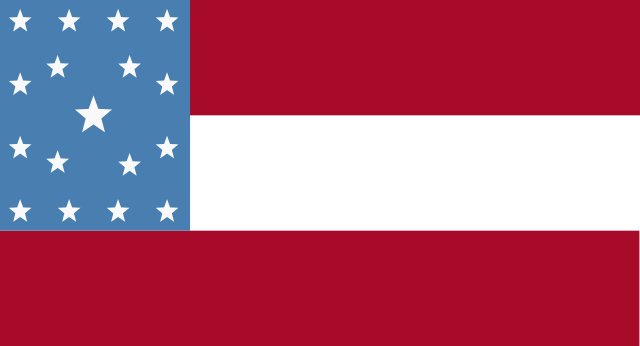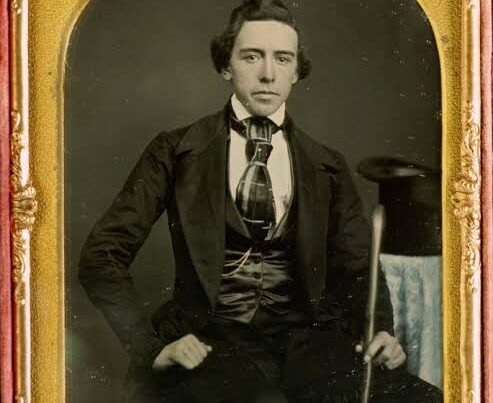
On July fourth 1861, Major J.P. Gillis made a public display of his support of colonial secession from the British Empire as well as Southern secession from the United States by parading in the streets with a Confederate flag of his own design. He drew cheers from a large crowd of onlookers, but two men named Curtis Clark and J.W. Biderman assaulted him and “captured” the Confederate flag. What makes Gillis and his flag noteworthy is the fact that this took place in Sacramento, California.
It might come as a surprise to some Americans that Southern traditions and ideas spread very far west during the latter part of the nineteenth century. The state of California was no exception. During the famous Gold Rush, the state received many Southern immigrants who brought with them, not slavery, but a culture of localized government, low tariffs, and individual sovereignty. Even with this generality in mind, it still may come as a surprise to some readers that California was as much as a hotbed for secessionist activity as other Southern states that never completely made it into the Confederate government, like Maryland or Kentucky. But there is indeed a unique Confederate experience that existed with residents of The Golden State.
Southern culture had been present in California during its early statehood, for example Senator William M. Gwin, a native from Tennessee, held a strong influence on California politics and championed the economic and social policies of that were held by Democrats in the South. Southern sympathy extended into the Californian executive as John Weller, who served as a governor from 1858-1860 supported the secession movement. As the prospect of the Southern states leaving the Union became more likely, Governor Weller made known his support for an independent Pacific Republic which would include California and Oregon. This proposed nation had support from many California citizens. A senator named Joseph Lane from Oregon also advocated for the independence of the Pacific states. The republic as proposed by Weller would probably have been neutral in the War Between the States, advocating only for the interests of the West, but the act of secession as a right was very clear for Governor Weller. However this first plan for California independence would never bear fruit as when the war started, the Federal government was quick to make sure that it would not lose control over the resources of California, or its access to the Pacific Ocean.
There was a continuous support for the Confederacy that was present in California throughout the war. Some would travel east to join the war; others persisted in having California join the Confederacy as a state.
One example of this latter form of support can be shown with A.J King, the undersheriff of Los Angeles County. A.J (Andrew Jackson) King was a native to Georgia who came West in 1852, and was a supporter for the Confederate States of America at the beginning of the split between Northern and Southern States. King was a leader for the secessionists in El Monte which was a major hotbed for Southern support in California. King was responsible for publicly displaying a lithograph of General Beauregard to a crowd of people, stating to U.S Marshal Henry D. Barrows that he thought that the Confederate government was “the only constitutional government we had”, and for attempting to organize a militia unit called the Monte Mounted Rifles that would aid the Confederacy. King was successful in having Governor Downey send firearms for the formation of the Monte Mounted Rifles, but Federal soldiers intervened, thus preventing the creation of a possible Californian Confederate militia group.
There was however, a secessionist militia that was successful in its formation. The Los Angeles Mounted Rifles were organized in the March of 1861 and were dedicated supporters of California sovereignty. It was one of many militia groups that formed at the beginning of the war in California; the petition for its formation was signed by influential members of the Los Angeles community. Some of these men were Joseph Lancaster Brent, a lawyer and former member of the state legislature who would go on to become a brigadier general for the Confederacy and Jose Antonio Sanchez, a leader for the large Mexican community in Los Angeles. The company serves history as a true representation of Southern California, amongst its members were Caucasians born in both the North and the South, European immigrants, and Hispanics. In fact, ten percent of the men who were listed on the Muster Roll had Spanish surnames. Some of these men were veterans of the Mexican-American War, of both sides, such as private Carman Frazee had fought with Jefferson Davis’ 1st Mississippi Rifles and the second lieutenant of the company, Tomas Sanchez who was a lancer in the Mexican army. The L.A Mounted Rifles would be led by a man named Alonzo Ridley, who was one of the famous “49’ners” that had come to California seeking riches. When the war began, the Rifles understood that it would be very difficult to aid the Confederate cause whilst in California, so they decided to travel east. Ridley led his men across the desert and into Texas. It was these Californian men who escorted Albert Sidney Johnston into Confederate territory, where he could take up his career as a general. Many of the units’ members could not make the journey and either stayed behind in California or made the trip at a later time. Such a man was the aforementioned Joseph Lancaster Brent, who would become the only Confederate general who was a California citizen. Those who did make it to the Confederacy would be scattered into different areas of the Southern army. For example, Captain Alonzo Ridley became a member of Johnston’s staff and served by his side until Johnston’s death at the Battle of Shiloh. The Los Angeles Mounted Rifles should be recognized as nearly a perfect cross section of the Californian population that supported the Confederacy; a mix of well-educated high standing members of society and middle class individuals that sought to protect and preserve the self-determination of their communities.
In addition to the men of the Mounted Rifles, were individual attempts to enfranchise the Confederate cause. Individuals attempts like those of Asbury Harpending. Born in Kentucky, Harpending traveled to California in and would make a fortune in mining. He supported the South at the onset of war and wanted to do his best to serve the Confederacy. In his own words, “it would have been hard to find a more reckless secessionist than myself.” Harpending was part of a plan to take control of San Francisco in order to establish the Pacific Republic that was previously mentioned. That plan didn’t come to pass, so Harpending decided to attack Union gold shipments. Harpending attained letters of marque from the Confederate government at Richmond in 1863 and outfitted a schooner called the J.M. Chapman that would be used to raid gold leaving from California that was carried aboard Union ships. Harpending met with as much success with this plan as the Pacific Republic, Union officials discovered the plan and the schooner was boarded by the U.S navy. Harpending was arrested but later released on a pardon granted by Abraham Lincoln in 1864.
These histories are but some of the legacies of the Confederates of The Golden State. Even these few examples of a unique population and geographic location could not be recorded in full with this work alone. Hopefully this under developed part of history will have more minds analyze it in the future.
Though California secession didn’t amount to independence in the West, the legacy of Californian rebels is important to Southern history. Without the Los Angeles Mounted Rifles’ timely departure to the East, it’s possible that Albert Sidney Johnston wouldn’t have reached the Confederacy until much later, if at all. The strong Southern sympathy in the West would last well after the war, and Southern traditions would flourish as best as they could in the Western states. It is also important for historians to make note of the fact that California had a high level of secession activity, in similarity with other border states during the war, but that California was not a slave state, providing evidence that secession was not instigated exclusively by slave owners. Many men would remain as essential members of their communities after the war, the outspoken secessionist A.J King remained the undersheriff of Los Angeles County throughout the entire war, serving as a testament to the enduring Confederate support of Californians.
To conclude with the rest of the story of the flag of J.P Gillis, an event that gives history a unique quarrel of a Confederate symbol. J.W Biderman stitched “Rebel flag. Captured 4 July 1861. By Jack Biderman” onto the banner. As far as it is known at this time, Major Gillis never recovered his flag and throughout the long years from then to now, the flag ended up on display at the California State Capitol Museum. The flag itself is in deserving of recognition as the only known Californian Confederate flag. Its design mirrors the Stars and Bars that served as the first national flag of the Confederacy. It bore two red bars with one white one in between them and a blue canton positioned in the upper left corner. But Gillis’ flag bore seventeen stars and were uniquely arranged instead of the circular formation of the Stars and Bars. The stars can be assumed to represent the fifteen Southern states that were displayed in early secession flags with California and Oregon as the final two additions. The flag serves as a symbol that may leave onlookers, with a powerful sense of ‘what might have been’ with regards to the success of Californian secession.






